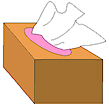Types of paper
This task is about comparing the physical properties of different types of paper.
|
Different types of paper have different uses.
Draw a line to match the different types of paper with their description. One description is not needed.
|
||
|
Type of paper |
Description of paper |
|
 |
Tissues • |
• Stiff, strong, has a water-proof wax coating.
• White or pale colours, smooth, will not easily soak up liquids.
• Soft, will easily soak up liquids, white and pale colours, tears easily.
• Strong, cannot be seen through, bright colours.
• Stiff, will not soak up grease or oils, tears easily.
• Strong even when wet, will easily soak up liquids like water and oil.
|
 |
Paper cup • | |
 |
Photocopy paper • | |
 |
Gift-wrapping paper • | |
 |
Paper towels • | |


